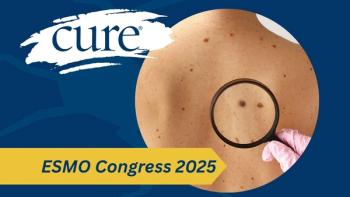
- Melanoma 2016
- Volume 1
- Issue 1
The New Front Line in Melanoma: Immunotherapy OR Targeted Agents?
In the fast-moving world of melanoma treatment, new therapeutic options for patients with metastatic disease are emerging faster than oncology researchers can establish guidelines for their optimal clinical use. That is raising questions about which should be the firstline choice in metastatic melanoma — targeted drugs or immunotherapy — and how these drugs should be sequenced.
In less than two months last year, the FDA approved five new or expanded indications for drugs. As it stands now, the National Comprehensive Cancer Network (NCCN) has identified seven single or combination therapies for first-line treatment of metastatic or unresectable disease, including three checkpoint immunotherapy agents and four targeted therapies.
Notably, single-agent Yervoy (ipilimumab), the CTLA-4—targeting antibody that launched the checkpoint therapy era, is now considered a second-line choice for metastatic or unresectable disease in the NCCN recommendations. (High-dose, single-agent Yervoy is recommended in the adjuvant setting.) Another novel therapy, Imlygic (TVEC, or talimogene laherparepvec), is recommended as primary treatment for stage 3 in-transit disease and in certain unresectable disease settings.
Until recently, the choice of first-line therapy in the metastatic setting would have turned on whether the patient had a BRAF gene mutation, a population that includes 37 percent to 50 percent of malignant melanomas, according to My Cancer Genome. Patients whose tumors harbor BRAF V600E or V600K mutation would most likely be recommended for therapy with a regimen including a targeted treatment known as a BRAF inhibitor.
Now, however, Opdivo (nivolumab) and Keytruda (pembrolizumab), both PD-1—targeting immunotherapies, are approved as first-line treatment for patients with metastatic disease even for those with BRAF mutations.
Although this bounty of choices is good news for patients with melanoma, several key questions have emerged: Should immunotherapy or targeted agents be the first-line choice for metastatic melanoma? And, does it make a difference how these agents are sequenced?
Those questions were discussed in detail recently at the 12th Annual International Symposium on Melanoma and Other Cutaneous Malignancies® that Physicians’ Education Resource (PER®) hosted in Miami Beach, Florida, on February 20, 2016.
Indeed, the issue was the focus of a Medical Crossfire session in which two of the world’s leading experts on melanoma therapy, Michael B. Atkins, deputy director of the Georgetown-Lombardi Comprehensive Cancer Center, and Jeffrey S. Weber, deputy director of NYU Langone’s Laura and Isaac Perlmutter Cancer Center, tackled the question in a debate-style format.
Despite making strong arguments for each viewpoint, both presenters and other leading researchers at the conference noted that questions about first-line systemic therapy for metastatic melanoma have not yet been fully resolved in clinical studies or by oncology experts.
The NCCN is in the process of updating its guidelines — even though they were last revised in November 2015 — and the Society for Immunotherapy of Cancer, which published the first consensus statement on the use of the emerging therapies in 2013, also is working on a new version.
THE CASE FOR IMMUNOTHERAPY
Atkins, who helped pioneer the development of the immunotherapies interleukin and interferon in melanoma treatment starting more than 20 years ago, argued that immunotherapy is the better choice for first-line treatment because of several factors.
He said immunotherapy produces durable, treatment-free responses while patients must continue to take BRAF inhibitors, and that clinical trials have demonstrated the checkpoint-targeting agents work as well against BRAF-mutant tumors as they do against disease not driven by BRAF mutations.
“I think immunotherapy accomplishes what the patients want, which is that it produces complete responses where you can stop the treatment and the response is maintained — so treatment-free survival,” Atkins said in an interview. “You don’t see that with the targeted therapies except in a rare patient population.”
As far as sequencing is concerned, Atkins said the use of immunotherapy followed by targeted therapy if needed offers the potential for “two shots on goal.” He cited a retrospective study that found that prior treatment with Yervoy did not negatively influence response to BRAF inhibition (which included single-agent and combination BRAF/ MEK regimens) but that outcomes with Yervoy following targeted therapy were poor.
Of 193 patients who had discontinued anti-BRAF therapy in that study, only 34 were able to go on to Yervoy treatment. Among these patients, the median progression-free survival (PFS) was 2.7 months and the median overall survival (OS) was five months. Those patients alive after one year went back on BRAF inhibitor therapy.
Moreover, Atkins said he believes “immunotherapy is now the better treatment.” He pointed to waterfall plots showing similar tumor shrinkage with combination BRAF/ MEK inhibition and Opdivo and more durable responses with immunotherapy agents. Updated data from a phase 1 study of Yervoy plus Opdivo combination therapy demonstrate that 68 percent of patients were alive after a median follow-up of 32.7 months.
“We know from immunotherapy that the majority if not all of the patients who are alive at three years are likely cured, and you just can’t say that with BRAF inhibitors,” said Atkins.
Further studies are needed to answer the sequencing question in patients with BRAF mutations, Atkins indicated. He is serving as the principal investigator on a National Cancer Institute (NCI)—sponsored phase 3 trial that will evaluate upfront therapy with Tafinlar (dabrafenib)/Mekinist (trametinib) followed by Yervoy/Opdivo, compared with the immunotherapy combination followed by the targeted therapy tandem.
Recruitment for the trial, which aims to enroll approximately 300 people, had been temporarily suspended because of a pending shortage of Tafinlar/Mekinist research drug supply at the NCI, according to Atkins. At press time, the trial (NCT02224781) was listed as recruiting.
Although he argued in favor of first-line immuntherapy treatment during the Medical Crossfire, in an interview Atkins discussed some of the nuances in making frontline recommendations.
He said starting with immunotherapy might not be as critical in the setting of combination checkpoint agents as opposed to single-agent immunotherapy, particularly for patients who are symptomatic from their disease. In such instances, he said, starting the patient with targeted therapy to cytoreduce the tumor and then administering immunotherapy might be a better option.
THE CASE FOR TARGETED THERAPY
Making the case for upfront targeted therapy for patients with BRAF mutations was Weber, who has helped develop checkpoint agents and targeted therapy strategies in melanoma and who served as program co-chair for the PER meeting.
The FDA has now approved two combinations that employ a dual pathway inhibition strategy: the BRAF inhibitor dabrafenib plus the MEK inhibitor Mekinist, and Zelboraf (vemurafenib) and Cotellic (cobimetinib), which inhibit the same pathways, respectively. The agents are approved in the metastatic setting for patients with BRAF V600E or V600K mutations.
Weber said that OS data for the combination of Tafinlar and Mekinist are more mature than findings from the Opdivo/Yervoy studies. An analysis of pooled data from three combination Tafinlar/Mekinist clinical trials demonstrated a median OS of 25 months to 26 months, with 36 percent of the patients remaining alive after four years.
“The urban legend of no tail on the curve is not true,” said Weber. “It is not true that as soon as you stop you will progress and not true that all will progress. There will be a significant tail on that curve.”
Weber elaborated on these thoughts in an interview. “The ‘urban legend’ was that the BRAF and MEK inhibitors had a high response rate, but almost all of the patients would progress quickly, progression-free survival would be less than one year, and most patients would have to go on another therapy or would die of their disease,” he said.
“That’s not exactly true. There does appear to be a plateau in the curve at about 30 percent for the patients who receive dabrafenib and trametinib,” said Weber. “I am sure
it will be virtually identical for vemurafenib and cobimetinib, which have a very similar median survival and one-year survival track record as dabrafenib and trametinib.”
Weber said a further argument for first-line combination targeted therapy is that clinical trial findings indicate that patients with normal lactate dehydrogenase (LDH) levels and less than three disease sites achieved better OS outcomes than those with a heavier disease burden. He said the one-year and three-year OS rates for patients in this category were 90 percent and 70 percent, respectively, “which is outstanding by any criteria.”
By contrast, he said, an analysis of overall response rates among participants who received the combination of Opdivo and Yervoy in the CheckMate-067 trial indicated that LDH and sites of disease are “weak prognostic factors for checkpoint inhibition.”
“These findings suggest that oncologists probably want to intervene with BRAF and MEK drugs earlier rather than later,” Weber said in the interview. “The targeted therapy will not work as well if patients are receiving immunotherapy first, then they progress, have high LDH and high disease burden. The association of patients doing well with targeted therapy with low disease burden bodes well for starting with targeted therapy and using immunotherapy in the second-line setting.”
Additionally, preclinical work suggests BRAF/MEK induction therapy administered over several weeks to a month “alters the tumor microenvironment, making a ‘cold’ tumor ‘hot,’” thus supporting a targeted therapy approach in the first line. “This is actually quite important,” he said. “It doesn’t work the other way.”
MORE VIEWPOINTS VOICED
Interviews with several of the other experts on the faculty at the PER conference illustrated other nuances associated with first-line therapy for patients with stage 4 disease that cannot be treated with curative intent through surgery.
Michael A. Postow, an assistant attending physician at Memorial Sloan Kettering Cancer Center who is among the most prominent researchers into checkpoint blockade strategies in melanoma treatment, said in an interview during the conference that he bases his recommendation on clinical factors.
“If a patient with a BRAF mutation has a lot of brain metastases or very symptomatic disease, I give that patient targeted therapy with BRAF and MEK inhibitors because we have more proven efficacy at this point about BRAF and MEK inhibitors in the brain than we do for immune therapy in the brain,” said Postow.
“Immune therapy can work in the brain, but we don’t have as much robust data for that as we do for the BRAF and MEK inhibitors. Also, the BRAF and MEK inhibitors have a very rapid onset of disease response,” he added. “But most patients, I try to give immune therapy to, if I can, as their first treatment, just because it has remarkable outcomes, and our hope is that long-term, those great outcomes will persist,” Postow said.
Tara C. Gangadhar, an assistant professor of medicine at the Abramson Cancer Center of the University of Pennsylvania in Philadelphia, said immunotherapy is often the first choice for frontline therapy at her center but not necessarily the combination of Opdivo plus Yervoy. Toxicities with the combine checkpoint agents are a concern, she indicated.
In the three-arm CheckMate-067 study, grade 3/4 adverse events (AEs) were reported in 55 percent of patients in the Opdivo/Yervoy group compared with 27.3 percent for Yervoy alone and 16.3 percent for Opdivo monotherapy. Diarrhea, colitis, increased lipase and increased ALT and AST levels (indicators of potential kidney and liver problems) were the most frequently reported grade 3/4 AEs.
“Patients with melanoma are so unique that the treatment plan has to be individualized,” said Gangadhar. “In some patients, we would choose this dual checkpoint blockade option. In all patients, we would consider whether there is a clinical trial option available in the first line that includes PD-1 blockade in combination with another agent that seems promising.” “Our preference is to use single-agent [immunotherapy] in the front line in the absence of randomized data showing an improved outcome with the combination compared with single- agent PD-1,” she added.
Although many questions regarding which approach is optimal remain unsettled, the cumulative upswing in outcomes for patients with melanoma is certain. “There are arguments for both sides,” Weber said in an interview. “But I do think all of these combinations are not only going to delay progression, but we are going to cure some of these patients.”
Articles in this issue
over 9 years ago
Wild Card: Treating Triple Wild-Type Melanoma




